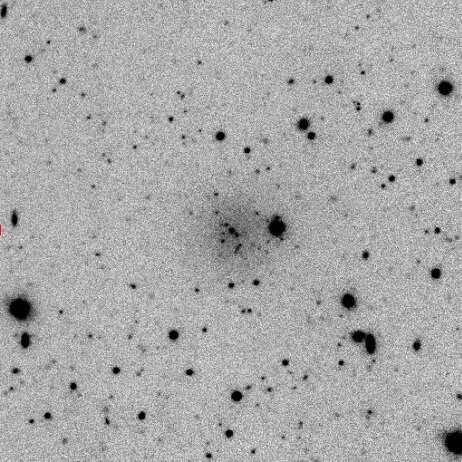May 23, 2019 report
New ultra diffuse galaxy found in the NGC 5846 group

Astronomers have detected a new ultra diffuse galaxy (UDG) located most likely in the NGC 5846 galaxy group. The discovery is part of the ongoing VEGAS survey aimed at investigating early-type galaxies in a range of environments. Details of the finding were presented in a paper published May 15 on arXiv.org.
UDGs are extremely-low-density galaxies. The largest UDGs have sizes similar to the Milky Way, but have only about 1 percent as many stars as our home galaxy. The mystery of UDGs is still baffling scientists as they try to explain why these faint but large galaxies are not ripped apart by the tidal field of their host clusters.
Although many UDGs have been found to date, the number of such galaxies identified in our cosmic neighborhood (within 100 million light years from the Earth) is still relatively small. Hence, any new addition to this short list of nearby UDGs is of high importance for astronomers aiming to disentangle the mysteries of these objects.
Now, a team of astronomers led by Duncan A. Forbes of Swinburne University in Australia, reports the finding of a new nearby UDG. Using the VLT Survey Telescope (VST) at the European Southern Observatory (ESO) in Chile, they conducted deep imaging of the NGC 5846 galaxy group as part of the VST survey of Early-type GAlaxieS (VEGAS).
Located some 81 million light years away from the Earth, the NGC 5846 group is dominated by two large ellipticals: NGC 5846 and NGC 5813. When analyzing the data from VEGAS, the researchers found one large, low-surface-brightness object, which turned out to be a UDG. The object was identified much closer in projection to NGC 5846 than NGC 5813, and received designation NGC 5846_UDG1.
"Here, we present the discovery of an ultra-diffuse galaxy, which we assume to belong to the NGC 5846 group. We name this object NGC 5846_UDG1," the researchers wrote in the paper.
According to the paper, NGC 5846_UDG1 is located most likely at a distance of about 81.5 million light years from the Earth and has an effective radius of approximately 6,850 light years. The galaxy's absolute magnitude was found to be -14.2, while its g band surface brightness at the effective radius was measured to be at a level of around 26 mag. sq.
Moreover, the study found that NGC 5846_UDG1 has a stellar mass of about 100 million solar masses and a halo mass greater than 80 billion solar masses.
The astronomers say that these values confirm the UDG nature of the newly identified galaxy. However, spectroscopic follow-up observations of this object are still required to verify that it belongs to the NGC 5846 group. Such studies could also provide essential information regarding internal kinematics of NGC 5846_UDG1 and its stellar population properties.
In concluding remarks, the researchers also noted that their discovery is promising in terms of finding other nearby UDGs. They hope to find more objects of this type in the deep and wide VEGAS survey images of massive nearby early-type galaxies.
More information: Duncan A. Forbes, et al. An Ultra diffuse Galaxy in the NGC 5846 group from the VEGAS survey, arXiv:1905.06415v1 [astro-ph.GA]. arxiv.org/abs/1905.06415
© 2019 Science X Network




















